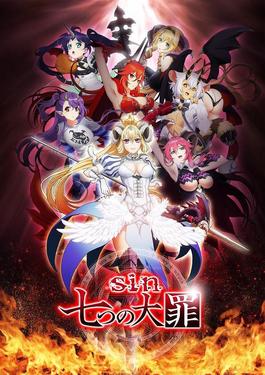“Seven Mortal Sins, also known as Sin: The 7 Deadly Sins (sin 七つの大罪, Sin: Nanatsu no Taizai), is a Japanese anime television series animated by Artland and TNK that aired from April 14, 2017, to July 29, 2017. It is an adaptation of Hobby Japan’s media franchise The 7 Deadly Sins (七つの大罪, Nanatsu no Taizai), which primarily consists of a series of fantasy figures.” —Ururihi, “Sin: Nanatsu no Taizai,” Wikipedia (retrieved January 24, 2024)
Junji Ito’s Horror Manga Uzumaki (1998-1999)
 “Uzumaki is the story of Kirie Goshima, a young girl living in a coastal town that is slowly falling into the grip of a ‘spiral curse.’ The townsfolk, to varying degrees, become obsessed and subsequently infected by spirals.
“Uzumaki is the story of Kirie Goshima, a young girl living in a coastal town that is slowly falling into the grip of a ‘spiral curse.’ The townsfolk, to varying degrees, become obsessed and subsequently infected by spirals.
“Ito-san’s spirals operate with similar symbolic significance to the circles of hell, namely, they are partly allegorical, as well as literal, of the spirals and endless cycles of human behavior…as in Dante’s hell all things become literal, he is physically twisted to reflect his psychological reality. Each person in Uzumaki is trapped in their own sin.
“Junji Ito understands, as Dante did, that even positive emotions like love have a place in hell when they are taken to extremes. Like a spiral itself, the story circles whilst drawing ever closer to a central point…like Dante, Junji Ito doesn’t flinch from showing us the full expanse and architecture of the hell he has created, and we see the very “nadir” or low-point of the spiral, and what that represents.” [. . .] –Joseph Sale, The English Cantos, April 8, 2020 (retrieved October 27, 2021)
«Noi leggiavamo. . .»: Visual re-mediations of Canto 5 in the journal Arabeschi
![]() In honor of Dantedì (March 25) 2021, the journal Arabeschi published a special issue dedicated to the visual re-mediations of the figures of Paolo and Francesca in Inferno 5. With an introduction by Gaetano Lalomia and Giovanna Rizzarelli, and featuring essays and virtual exhibits by Marcello Ciccuto, Laura Pasquini, and others, the special issue covers in depth the rich history of iconographic reception, across various visual media, of the story of Dante’s star-crossed lovers in the 20th and 21st centuries. At right is a screenshot of selected contributions to the issue.
In honor of Dantedì (March 25) 2021, the journal Arabeschi published a special issue dedicated to the visual re-mediations of the figures of Paolo and Francesca in Inferno 5. With an introduction by Gaetano Lalomia and Giovanna Rizzarelli, and featuring essays and virtual exhibits by Marcello Ciccuto, Laura Pasquini, and others, the special issue covers in depth the rich history of iconographic reception, across various visual media, of the story of Dante’s star-crossed lovers in the 20th and 21st centuries. At right is a screenshot of selected contributions to the issue.
Read the full issue (with image gallery) here.
Read the introduction by Lalomia and Rizzarelli here.
Cesare
From Volume 2, Chapter 10, in Fuyumi Soryo’s 2005 manga series Cesare, which makes extensive reference to the Divine Comedy.
Underworld – Saint Seiya
“The Underworld (冥界, Meikai) or Inferno (地獄, Jigoku) is the realm of the dead where souls are placed after death. What area the souls reside in are determined by the Three Judges. It is the habitat of all Specters, including the god Hades (in classic myth, it is also the second residence of Hades’s wife, Persephone).
“The Meikai Underworld was created by Hades to forever punish humans for their crimes. No life is possible in the Underworld without the Eighth Sense (or special devices), as all things in the Underworld normally fall under the control of Hades. Specters are unaffected, and may enter and leave at the discretion of Hades because they wear Surplices.
“As depicted by Masami Kurumada, the Underworld is composed of eight prisons, with further subdivisions (the 7th prison is divided in three valleys, the 8th in ten pits, the 9th in four regions). All of the Prisons correspond to the nine Circles of Hell depicted in Dante Alighieri’s Divine Comedy, which itself borrows heavily from Greek myths. In addition, it also contains the passage to the Elysian Fields, where only those chosen by the gods can go.” —Seiyapedia, September 12, 2018
Learn more about the Saint Seiya series here.



